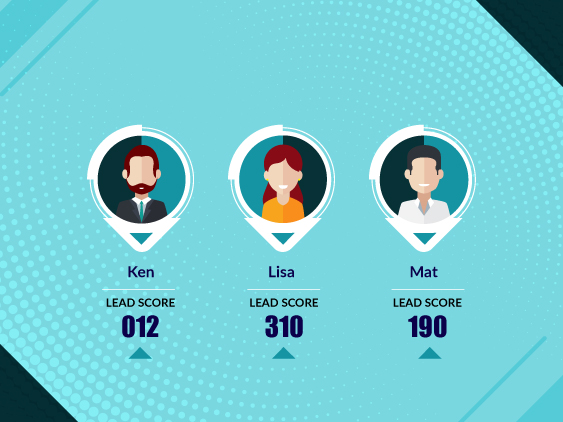When companies start with their Lead Generation efforts, the primary aim is always to bring in more leads to the Sales funnel. The quality of leads is not really a concern at the beginning. But once there are enough leads to move forward to the next step, a necessity to prioritize certain leads over another leaps up. They need to figure out which prospects are the most interested in buying, and which are just “looking around” at the moment.
This makes it easier for the Sales team to contact the most probable customers first and the Marketing team to nurture the leads into customers over time.
Enter: Lead Scoring
As per Marketo, Lead Scoring is a shared Sales and Marketing methodology for ranking leads in order to determine their Sales-readiness. You score leads based on the interest they show in your business, their current place in the buying cycle and their fit in regards to your business. Companies can score leads by assigning points, implementing rankings like A, B, C, D, or using terms like ‘hot’, ‘warm’ or ‘cold’. The key point is that Marketing and Sales increase their combined efficiency and productivity based on the clarity of a Sales-ready lead.
HubSpot defines it as “the process of assigning values, often in the form of numerical “points,” to each lead you generate for the business.” It explains that a business can score its leads based on multiple attributes, including the professional information they’ve submitted and how they’ve engaged with the website and brand across the internet. This process helps Sales and Marketing teams prioritize leads, respond to them appropriately, and increase the rate at which those leads become customers.
Yet, 79% of B2B marketers have not established Lead Scoring in their systems!
TechTarget defines Lead Scoring as “a methodology used by Sales and Marketing departments to determine the worthiness of leads, or potential customers, by attaching values to them based on their behavior relating to their interest in products or services. The “value” of each lead varies from company to company, but generally is characterized by the interest shown in the company or their places in the buying cycle.
Companies assign point-based systems in qualifying leads or simply refer to them as “hot,” “warm” or “cold” based on the history of interactions.”
What Makes Lead Scoring Important?
Now that you have obtained a list of prospects, how do you proceed forward?
If you go about contacting every lead on the list one by one, it would be too late to contact those prospects that are way down on the list. It has been found out by InsideSales that 35-50% of sales go to the vendors who respond first. So, by the time you would contact a lead, chances are some other company might have already contacted them and the lead becomes nothing more than a useless contact to you.
In order to avoid this, organizations make use of a Customer Relationship Management (CRM) system to score leads. In this way, the leads that are more likely to convert into customers can be assigned top priority and contacted at the earliest. Don’t forget, as much as 70% of opportunities are lost because of poor follow-up.
Read More: SalesTech Star Primer: What Is Lead Generation?
The Process of Lead Scoring
Marketing Automation helps companies obtain historical data that they may use to foresee a typical path that a customer takes before buying. In conjunction with Inbound Marketing, Lead Nurturing, and Customer Data, Marketing Automation can help organizations to find out which pieces of content worked best in converting a prospect into a customer.
For instance, let’s say a large number of prospects have downloaded an e-book, but haven’t bought anything. This may mean that they might be interested, but do not intend to buy any soon.
On the other hand, if a large section of the prospects have filled-in a form to request a demo of your offerings, and have then gone on to actually buy something, this means the forms are performing well. Thus, downloading e-books will get a prospect much fewer points on the Lead Scoring table than someone who requests a demo.
As simple as that!
- In order to score leads, the Sales and Marketing teams of an organization need to decide on a common definition of qualified lead.
- The next step is to gather information about the lead’s occupation and role in that industry. Information about the lead’s activities, interests, and demographics, etc., help with deciding if the lead is relevant or not. Browsing behaviors and engagement with the brand can signal if the prospects are likely to convert.
- A CRM system comes in handy to assign a point value depending on how likely the software forecasts that action will lead to a purchase. Points can be assigned for relevant actions such as reading a blog post, commenting on a post, opening e-mails, replying to e-mails, time spent on website, reviewing your products/services, making enquiries, etc.
- Prospects that have expressed a high interest in the company or the products/services are termed as “Marketing Qualified Leads” (MQLs) and passed on to the Sales teams. Only 25% of all leads are genuine enough to be passed on to the Sales department.
- Prospects that are good fit, but have had less interaction (and have thus scored less) are passed on to the Marketing teams for the purpose of Lead Nurturing.
Source: Pardot
Having a proper lead scoring system can help organizations increase conversation rates and bring down the number of lost opportunities.
In addition, productivity improves as priorities and road-maps are set in advance. The marketing and sales teams collaborate well and align better towards achieving higher ROI for the company. No wonder 68% of the best B2B marketers attribute their success to Lead Scoring.
Read More: What is Demand Generation?





















